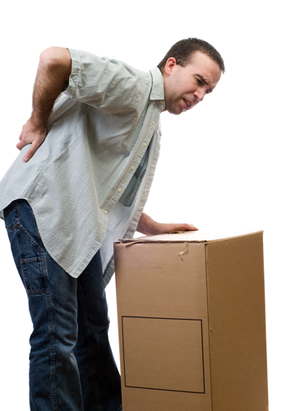 Lower Back PainLower back injuries are very common. Research tells us that 80% of people suffer from back pain at some time or another. Back pain is one of the leading causes of disability with significant health care costs in addition to lost productivity and suffering.
Lower Back PainLower back injuries are very common. Research tells us that 80% of people suffer from back pain at some time or another. Back pain is one of the leading causes of disability with significant health care costs in addition to lost productivity and suffering.Problems or injuries to the muscles, nerves, joints and discs are the most common causes of low back pain. With overlapping injuries and possibly more than one area or tissue injured, differentiating the specific injury can be difficult. This is a brief list of the different problems and typical associated symptoms that we commonly see. This general information is offered to help you better understand the possible problems. For more specific information please schedule a consultation.
Disc injury
The flexible discs between vertabrea allow for movement, but are a frequent source of pain in the lower back. With damage ranging from a minor sprain (internal disruption) to a severe herniation, the pain level can also vary from minor to severe.
- Pain referral or radiation is common – with symptoms including numbness, pain or weaknesses into the hip or leg
- Will often restrict mobility
- Typical pattern includes early morning pain, pain with sitting, relief with standing/walking
 Lifting Injury
Lifting InjuryJoint “sprain”
Between each vertebrae there are small joints (facet joints) that help guide motion – excess stress/strain on these small joints can result in a joint “sprain” or irritation.
- Pain can be sharp or dull, locally or referred into the hip/leg
- Often restricts range of motion (sometimes in very specific movements)
- Frequently described as a “kink” or “pinch”
- Very common injury
Muscle or myofascial irritation
The spine is supported by the surrounding muscles. The “core” muscles provide mobility, strength, stability and feedback on positioning. Prolonged periods or excess strain can injure the muscle fibres and lead to pain, tension or discomfort.
- Can range from stiffness to severe pain. Either aching or sharp pain
- Can restrict mobility
- Very common, often happens in concert with other injuries
- Pain alone can trigger increased muscle tension – which in-turn leads to more pain
 Exercising InjuryNerve “pinch”/compression
Exercising InjuryNerve “pinch”/compressionOften pain referring down the leg is blamed on a “pinched nerve” or “sciatica”. Nerves can be “pinched” in the back from a disc injury, with osteoarthritis, degenerative changes or from an injury.
- Typical nerve pain is severe and sharp/stabbing
- An cause numbness, total loss of feeling or weaknesses
- True nerve compression is not very common. More often pain referral stems from muscle, joint and disc problems – even if the nerve is not being directly affected
Often pain is blamed on osteoarthritis. Degenerative damage like osteoarthritis can trigger pain episodes, but that pain often persists for other reasons. The goal of treatment is to identify the underlying factors for the reoccuring pain, and to bring those issues under control with a combination of treatment, home exercises and ergonomic changes.
While it is not possible to undo the arthritic changes, treatment can often restore normal function and reduce pain.
 Pregnancy Back PainTreatment
Pregnancy Back PainTreatmentTreatment must always start with an appropriate diagnosis.
Treatments should focus on the underlying cause of the pain - both the tissue causing the pain as well as the factors triggering the problem. A combination of treatments, such as, massage, soft tissue treatments (Graston), manipulation/mobilization and/or home stretching exercises can be effective ways to reduce the tissue irritation.
We identify aggravating factors and help you manage any issues through a program of self-care and prevention.
For a clinical assessment of your lower back pain, the triggers and best treatment options, please contact Bedford Chiropractic for an appointment.
